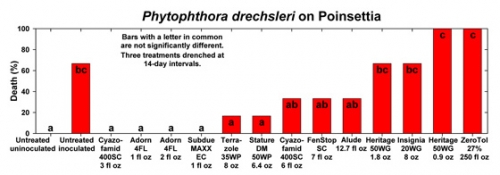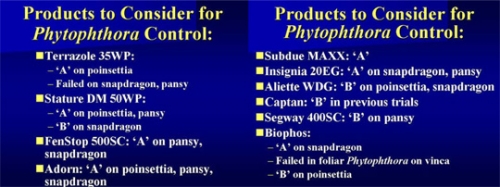Greenhouse disease update for Phytophthora root rot
Editor’s note: This article is from the archives of the MSU Crop Advisory Team Alerts. Check the label of any pesticide referenced to ensure your use is included.
Phytophthora (Phytophthora nicotianae and Phytophthora drechsleri are examples) can be found in floriculture crops and can cause root, crown and foliar blights. Losses can be especially severe in greenhouses and production fields where warm temperatures and ample water favor epidemics. Recirculating irrigation water can enhance the spread of Phytophthora.
Phytophthora is difficult to control because it produces several different spores that can cause disease. Thick-walled oospores survive between crops on plant containers, benches, floors and in potting media or soil. Other spores include lemon-shaped sporangia, thick-walled chlamydospores and swimming zoospores. Water is important for disease and under warm, wet conditions many spores develop on infected plants and lead to a rapid build-up of disease and spread in a short period of time.
Once an epidemic has developed in a production site it is often difficult to determine how the Phytophthora was introduced, how it is spreading, and if it is surviving from year to year. Using genetic tools, research conducted at MSU showed that Phytophthora spread within the greenhouse can occur from sporangia that can travel through the air or zoospores that spread through the water. Recent research also shows how Phytophthora may spread among producers. For instance, snapdragon producers at two locations purchased plugs from the same supplier. The Phytophthora from the two locations was identical. While it is possible that the disease was introduced to the locations via infected plants, it is also possible that the Phytophthora was already established at these production sites. The Phytophthora recovered from snapdragons was identical to the Phytophthora collected from the same facility in a previous year indicating the potential for this pathogen to survive even with a fallow period and treatment with a fumigant (methyl bromide/chloropicrin).
Controlling the spread of Phytophthora spp. within and among production facilities can be difficult and there are two major challenges. First, Phytophthora must be kept out of the production site. This is particularly difficult with floriculture crops because of the widespread distribution of pre-finished plants. Also, plants may not exhibit obvious symptoms until the infection is well established or the plant becomes stressed (e.g., over- or under-watering). Infected plants treated with fungicides may appear healthy until the fungicides wear off and Phytophthora increases. The second challenge is eradicating Phytophthora once it has been introduced. Removing visibly diseased plants will not prevent spore production and spread from plants showing few if any symptoms. Sanitation can limit disease and includes removing plant debris, disinfecting pots, and production surfaces. Routinely treating plants with fungicides including mefenoxam (Subdue MAXX) can be helpful.However, Phytophthora can develop resistance to these fungicides and new management strategies and tools are needed.
Evaluation of registered and unregistered fungicides in managing Phytophthora root rot of poinsettia
Disease pressure was severe with 66.7 percent of the untreated inoculated plants dead with the remaining alive plants severely stunted.Adorn 4FL (both rates) and commercial standard Subdue MAXX were the only treatments that resulted in plants showing no symptoms from Phytophthora and received plant health ratings of 1.0 (1 equals healthy, 5 equals plant death).Alude significantly reduced infection compared to the untreated inoculated while ZeroTol had 100 percent plant death by the second rating date.A high and low rate of the unregistered fungicide Cyazofamid, Heritage, and Adorn were included in this trial with no significant differences between the rates for each treatment on the last rating date.Strobilurin products Heritage and Insignia were not effective in controlling infection and resulted in plant health and death (percentage) similar to that of the untreated inoculated.No phytotoxicity was observed on any of the treated plants in this trial.


Acknowledgements
This research was funded in part by Floriculture Nursery and Research Initiative of the Agricultural Research Service under Cooperative Agreement #59-1907-5-553 and by the American Floral Endowment.

Dr. Hausbeck's work is funded in part by MSU's AgBioResearch.



 Print
Print Email
Email



